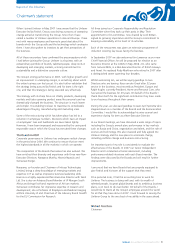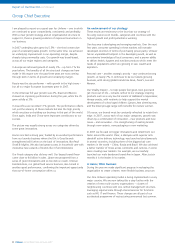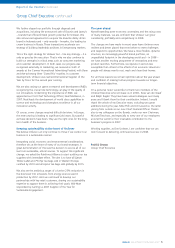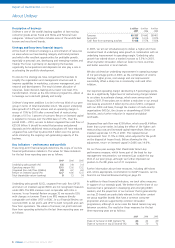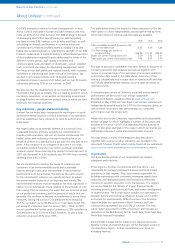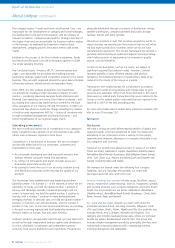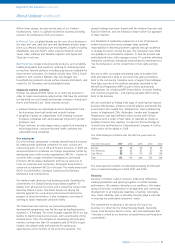Unilever 2007 Annual Report Download - page 15
Download and view the complete annual report
Please find page 15 of the 2007 Unilever annual report below. You can navigate through the pages in the report by either clicking on the pages listed below, or by using the keyword search tool below to find specific information within the annual report.
The following discussion about outlook and risk management
activities includes ‘forward-looking’ statements that involve risk
and uncertainties. The actual results could differ materially from
those projected. See the ‘Cautionary statement’ on the inside
back cover.
Outlook
Our strategy is to focus our resources on our priority areas of
Vitality, personal care, and developing and emerging markets,
where we are well placed to achieve sustainable profitable growth
with our brands and strong value creation for our shareholders.
This is the basis for our strategic plan which aims to deliver
consistent and competitive underlying sales growth in the 3-5%
growth range per annum and an operating margin improving to a
level in excess of 15% by 2010. The underlying sales growth
range is based on market growth of typically around 3-4%, and
reflects our ambition to strengthen our leadership positions over
time.
In August 2007, we announced new plans to accelerate change
of Unilever, including a step-up in innovation, plans to shape our
portfolio, and measures to improve our margins, to strengthen
and further enhance Unilever’s financial performance.
These plans include the creation of multi-country organisations in
all regions, closure or streamlining of 50-60 factories and a
further reduction in global and regional overheads. These changes
aim to deliver a reduction in our annual cost base by around
€1.5 billion by the end of 2010, compared with our 2006 cost
base. The related restructuring charges are estimated to amount
to about 2.5% of sales on average per annum in the period
2007–2009. For 2010 and beyond, we expect restructuring costs
to come down to a ‘normal’ level of 0.5% to 1% of turnover per
annum.
We also announced our intention to dispose of brands and
businesses with a combined turnover in excess of €2 billion,
including the sale of our North American laundry business. The
focus is on brands that do not have a longer-term strategic fit
with our strategy and business model or have a strategically
disadvantaged position in their particular markets. These value-
enhancing disposals are expected to collectively improve the
underlying sales growth rate of our business by around 0.4
percentage points and will be neutral to operating margin, after
removal of uncovered costs.
We also expect to improve our return on invested capital over
time, above the base level of 11% in 2004, and to generate
ungeared free cash flow of €25-30 billion over the period
2005–2010. It should be noted that previous and planned
disposals and the additional restructuring plans will have reduced
ungeared free cash flow by about €2.5 billion over this period,
while enhancing the ongoing cash generating capacity of the
business.
In February 2008 we indicated that in 2008 we expect underlying
sales growth to be towards the upper end of our 3-5% target
range, and to see a further underlying improvement in operating
margin. In the three-year period 2005–2007, Unilever generated a
cumulative ungeared free cash flow of €12 billion, towards the
€25-30 billion target for the six-year period 2005–2010.
Risk management
Unilever’s system of risk management is outlined on page 66.
Responsibility for establishing a coherent framework for the
Group to manage risk resides with the Boards. The remit of the
Boards is outlined on page 33.
Particular risks and uncertainties that could cause actual results to
vary from those described in forward-looking statements within
this document, or which could impact on our ability to meet our
published targets, have been identified. Unilever has described
some mitigating actions it intends to take to address the risks set
out below. These actions may not succeed in mitigating these
risks. Additionally, Unilever may not be successful in deploying
some or all of these mitigating actions, which may impair
Unilever's profitability or adversely impact its reputation.
Sales and profit growth
The increasingly competitive environment, the further
consolidation in the marketplace and continued growth of
discounters could adversely impact our rate of sales growth and
our profit margins. In the light of this, we will continue to invest
in selected brands and high growth market areas in an effort to
deliver profitable sales growth.
During 2007 we have reinforced our ability to deliver growth by
continuing to dispose of low growth or non relevant components
in the category portfolio (i.e. those that do not fit with the
strategy). This we believe has the impact of concentrating brand
strength and therefore reducing the risk of brand equity loss or
impairment in our global brands. It also improves our overall
competitive position on a global basis by shifting more turnover
weight into high growth-high share business as a percentage of
our total portfolio. We will continue to actively manage our
portfolio with the goal of improving investor returns by
strengthening the competitive position of our business. This, we
believe, will also reduce business risk by minimising the weakness
in our portfolio.
Our continued sales and profit growth depends in large part on
our ability to generate and implement a stream of consumer-
relevant improvements to our products. The contribution of
innovation is affected by the level of funding that can be made
available, the technical capability of the research and
development functions, and the success of operating
management in rolling out quickly the resulting improvements.
Our focus will continue to be on developing our brands in ways
that are distinctive and are relevant for our customers.
We have a number of large global brands, including 12 with an
annual turnover greater than €1 billion, which often depend on
global or regional development and supply chains. Any adverse
event affecting consumer confidence or continuity of supply of
such a brand could have an impact in many markets. The carrying
value of intangible assets associated with our brands is significant,
and depends on the future success of those brands. There
remains a risk that events affecting one or more of our global
brands could potentially impair the value of those brands.
Unilever Annual Report and Accounts 2007 13
Report of the Directors continued
Outlook and risks


